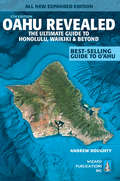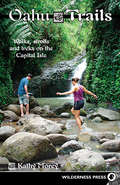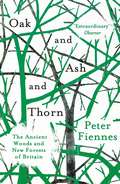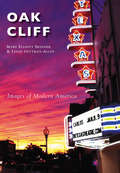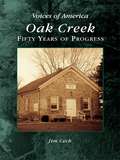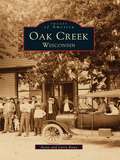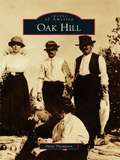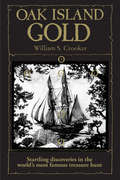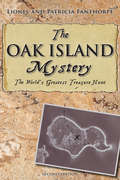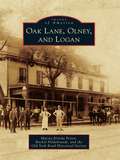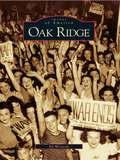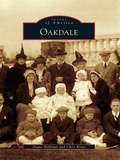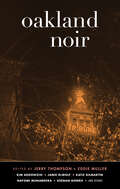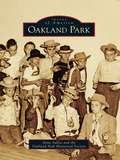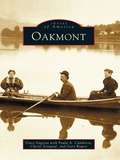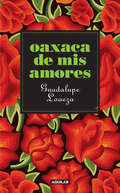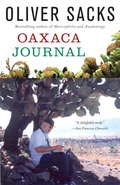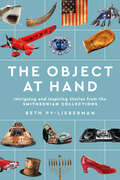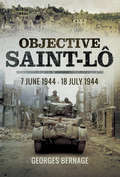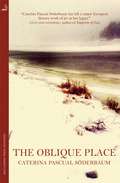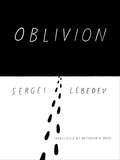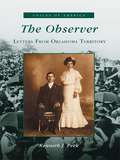- Table View
- List View
Oahu Revealed: The Ultimate Guide To Honolulu, Waikiki & Beyond
by Andrew Doughty Leona BoydThe finest guidebook ever written for O'ahu. Now you can plan your best vacation--ever. This all new expanded fifth edition is a candid, humorous guide to everything there is to see and do on the island. Written by the author of the best-selling guides, Maui Revealed, Hawaii The Big Island Revealed and The Ultimate Kauai Guidebook. Explore with him as he reveals breathtaking trails, secluded beaches, pristine reefs, delicious places to dine, relaxing places to stay, exciting waterfalls, colorful valleys and so much more. Every restaurant, activity provider, business and resort is reviewed personally and anonymously. This book and a rental car are all you need to discover what makes O'ahu so exciting.* The most up-to-date and accurate information available anyplace with up-to-the-minute changes posted to our website* Frank, brutally honest reviews of restaurants, hotels and activities show you which companies really are the best...and which to avoid--no advertisements* Driving tours let you structure your trip your way, point out sights not to be missed along the way and are complemented by over 150 spectacular color photographs* 21 specially-created maps in an easy-to-follow format with landmarks--so you'll always know where you are on the island* Clear, concise directions to those hard-to-find places such as deserted beaches, hidden waterfalls, lush rain forests, spectacular coastlines and scores of other hidden gems listed nowhere else* Exclusive chapter on O'ahu's beaches with detailed descriptions including ocean safety* Unique Adventures & Attractions chapter, over 60 pages of exciting activities from ATVs to whale watching, and over 200 restaurant reviews* Fascinating sections on Hawai'i's history, culture, language and legends* Companion website with links to every business, events calendar, over 80 resort reviews complete with aerial photos--so you'll know if oceanfront really means oceanfront Oahu Revealed covers it all--from the top of the Ko'olaus to the lost sunken island off Kane'ohe. This is the best investment you can make for your O'ahu vacation. Whether you are a first time visitor or a long time kama'aina, you will find out more about O'ahu from this book than from any other source. Discover the island of your dreams with Oahu Revealed.
Oahu Trails
by Kathy MoreyThis guide to 45 great hikes on Oahu includes 2 new trips in the inland rainforests of Kailua and Waimanalo. Explore the beaches, cliffs, and rainforests, and learn about native plants, Hawaiian history, and local mythology.
Oak and Ash and Thorn: The Ancient Woods and New Forests of Britain
by Peter FiennesA Guardian Best Nature Book of the Year The magic and mystery of the woods are embedded in culture, from ancient folklore to modern literature. They offer us refuge: a place to play, a place to think. They are the generous providers of timber and energy. They let us dream of other ways of living. Yet we now face a future where taking a walk in the woods is consigned to the tales we tell our children. Immersing himself in the beauty of woodland Britain, Peter Fiennes explores our long relationship with the woods and the sad and violent story of how so many have been lost. Just as we need them, our woods need us too. But who, if anyone, is looking out for them?
Oak Cliff (Images of Modern America)
by Mary Elliott Skinner Leigh Gettman-AllenThe community of Oak Cliff is one of progress and transformation, experiencing a "rebirth" over the last few decades. Covering approximately one fourth of Dallas County, Oak Cliff has become one of the most ethnically diverse and culturally opulent neighborhoods in the state of Texas. From the events surrounding the death of Pres. John F. Kennedy to the demographic shifts over the last 40 to 50 years, Oak Cliff has become a symbol of inimitability, re-establishing its image as one of the most desirable neighborhoods in the United States.
Oak Creek: Fifty Years of Progress
by Jim CechIn the early 1830s, U.S. officials forced the Menomonee and Potawatomi Indians to give up their lands in present-day Milwaukee County. Men from England and the eastern United States purchased large tracts of land along Lake Michigan from the government. Settlers like John Fowle, George Cobb, and Luther Rawson brought families to southeastern Wisconsin and helped establish the town of Oak Creek. For more than 100 years, Oak Creek retained its township status and rural character. But in 1955, Milwaukee city leaders attempted to annex Oak Creek's land and collect income tax revenue from a recently completed power plant. The small town won a legendary incorporation battle with their powerful northern neighbor, setting a precedent that also saved Franklin and Greenfield from being absorbed by Milwaukee.
Oak Creek, Wisconsin
by Larry Rowe Anita RoweOak Creek, Wisconsin, is a close-knit community with a long tradition of farming. Authors Anita and Larry Rowe have compiled this volume of photographs from the Oak Creek Historical Society, CNI newspapers, and many longtime residents to trace the history of Oak Creek from the turn of the century, when the community was mostly farmland, to its incorporation as a city in the 1950s. With this glimpse into Oak Creek's past, residents of all ages will delight in discovering the unique heritage of this city in southeastern Wisconsin. The images featured, many of which have never before been published, offer rare views into the daily lives of the area's early settlers at work and at play. Family histories, Oak Creek's struggle for an independent identity outside of the city of Milwaukee, the stories behind the historic buildings at the Oak Creek Historical Museum, and the colorful past of the city's taverns are all brought to life in Oak Creek, Wisconsin.
Oak Hill (Images of America)
by Dana Baldwin ThompsonBeginning with the Timucuan Indians around 2000 BC, life along the Indian River in Oak Hill has always been simple. The natural beauty and pristine environment that drew Oak Hill's first inhabitants to the area still abounds, and the waterfront lined with large oak trees continues to inspire a feeling of serenity and relaxation. The first Florida pioneers settled in Oak Hill around 1870 and were drawn by the treasures of a diverse ecosystem of marshland, cypress hammock, and timber pine forest. These first settlers harvested the natural resources of timber, turpentine, and salt, followed by citrus groves and a thriving fishing industry. The selected photographs in this book, many appearing courtesy of local families, document the lives and times of Floridians who chose to call Oak Hill home.
Oak Island Gold
by William S. Crooker&“Crooker, who is a good historian and also quite witty, tells a tale of folly and obsession&” surrounding the legendary treasure off of Canada&’s east coast (Booklist). For over two centuries, the mysterious labyrinth of shafts and tunnels under Oak Island, a tiny island on Nova Scotia&’s South Shore, has been the scene of a frantic search by scores of treasure hunters from two continents. They believe that the shafts and intricate man-made flooding system hold the secret to a treasure of untold wealth. Although millions have been spent, bitter feuds have erupted, and men have died, the treasure has remained as elusive as the answers to who built the labyrinth, why and how it was constructed, and the nature of the treasure itself. Until now. In his second book on the Oak Island mystery, William Crooker meticulously sifts through the evidence unearthed by treasure hunters on the island, past and present. Then, armed with some starling new discoveries, he neatly fits the pieces together to offer a plausible solution to the baffling puzzle of Oak Island.&“Crooker, an engineer and surveyor, presents both a thorough historical review of the various digs and a look at all the theories about the treasure.&” —Library Journal
Oak Island Gold: Startling New Discoveries In The World's Most Famous Treasure Hunt
by William S. Crooker“Crooker, who is a good historian and also quite witty, tells a tale of folly and obsession” surrounding the legendary treasure off of Canada’s east coast (Booklist).For over two centuries, the mysterious labyrinth of shafts and tunnels under Oak Island, a tiny island on Nova Scotia’s South Shore, has been the scene of a frantic search by scores of treasure hunters from two continents. They believe that the shafts and intricate man-made flooding system hold the secret to a treasure of untold wealth. Although millions have been spent, bitter feuds have erupted, and men have died, the treasure has remained as elusive as the answers to who built the labyrinth, why and how it was constructed, and the nature of the treasure itself. Until now. In his second book on the Oak Island mystery, William Crooker meticulously sifts through the evidence unearthed by treasure hunters on the island, past and present. Then, armed with some starling new discoveries, he neatly fits the pieces together to offer a plausible solution to the baffling puzzle of Oak Island.“Crooker, an engineer and surveyor, presents both a thorough historical review of the various digs and a look at all the theories about the treasure.” —Library Journal
The Oak Island Mystery: The Secret of the World's Greatest Treasure Hunt
by Lionel Fanthorpe Patricia FanthorpeThe Oak Island mystery has been the world’s greatest and strangest treasure hunt, and after years of research the authors have finally solved the sinister with an answer that is challenging, controversial, and disturbing. In 1795 three boys discovered the top of an ancient shaft on uninhabited Oak Island in Mahone Bay, Nova Scotia. The boys began to dig, and what they uncovered started the world’s greatest and strangest treasure hunt but nobody knows what the treasure is. Two hundred years of courage, back-breaking effort, ingenuity, and engineering skills have failed to retrieve what is concealed there. Theories of what the treasure could be include Captain Kidd’s bloodstained pirate gold, an army payroll left by the French or British military engineers, priceless ancient manuscripts, the body of an Arif or other religious refugee leader, or the lost treasure of the Templars. The Oak Island curse prophesies that the treasure will not be found until seven men are dead and the last oak has fallen. That last oak has already gone, and six treasure hunters have been killed. After years of research, the authors have finally solved the sinister riddle of Oak Island, but their answer is challenging, controversial, and disturbing. Something beyond price still lies waiting in the labyrinth.
Oak Lane, Olney, and Logan
by Old York Road Historical Society Marita Krivda Poxon Rachel HildebrandtThe northern neighborhoods of Philadelphia, which include East Oak Lane, West Oak Lane, Olney, Logan, and Fern Rock, were first settled in the late 1600s and gradually evolved into distinct communities. Old York Road and other historical roadways connected the local farms, mills, and estates to adjoining Philadelphia and Germantown. Images of America: Oak Lane, Olney, and Logan is the first book to chronicle the history of these neighborhoods through rare photographs gathered from a variety of private and public collections. Pictured are the schools, churches, businesses, theaters, hospitals, row houses, and apartment buildings that characterize the area, as well as the estates of notables, including James Logan, Fannie Kemble, Charles Wilson Peale, Joseph Wharton, and T. Henry Asbury.
Oak Ridge (Images of America)
by Ed WestcottOak Ridge is nestled in the foothills of East Tennessee, 25 miles west of Knoxville. Bordered on three sides by the Clinch River, the land first existed under other names--Elza, Robertsville, Scarboro, and Wheat--and became part of the Clinton Engineering Works later known as Oak Ridge. In 1942, 59,000 acres of land were transformed in a matter of weeks into a "secret city" that became known as the mysterious Manhattan District. As a direct result of the letter written by Albert Einstein to Pres. Franklin D. Roosevelt in 1939, the Manhattan District was created to develop new atomic weapons. Finally named Oak Ridge in 1943 and now thriving with a population of over 27,000, the town continues to be a significant center for the advancement of science and technology used throughout the world. In this pictorial history, photographs and personal descriptions guide readers on a visual journey of the construction of a city and the creation of the atomic bomb, to the post-war transformation of Oak Ridge into a major scientific community in the South.
Oakdale
by Chris Kretz Diane HollidayWhen Oakdale began in the 1680s, it was a woodland wilderness. Following the American Revolution, farmers cleared and worked the land. "Oyster King" Jacob Ockers and his men followed, working the bay. The railroad ushered in wealthy sportsmen to the South Side Sportsmen's Club. Some of these men, like William K. Vanderbilt and William Bayard Cutting, stayed and built palaces for their families. The scene changed starting in the 1920s, bringing flappers, artists, bootleggers, and Broncho Charlie, the last living Pony Express rider. The former mansions of the well-to-do now served as homes to a military academy and a religious cult, while still retaining their turn-of-the-century style.
Oakland Noir (Akashic Noir)
by Nick Petrulakis Kim Addonizio Keenan Norris Keri Miki-Lani Schroeder Katie Gilmartin Dorothy Lazard Harry Louis Williams II Carolyn Alexander Phil Canalin Judy Juanita Jamie DeWolf Nayomi Munaweera Mahmud Rahman Tom McElravey Joe Loya Eddie Muller"Wonderfully, in Akashic's Oakland Noir, the stereotypes about the city suffer the fate of your average noir character--they die brutally. Kudos to the editors, Jerry Thompson and Eddie Muller, for getting Oakland right. All those outsize statistics don’t reveal a real city, but this collection of local voices--both established and new--brings it thrumming to life...Readers who know the city will relish its sense of place, and those who only know the stereotypes will be in for a pleasing eye-opener.”--San Francisco Chronicle“From the Oakland hills to the heart of downtown, each story brings Oakland to life."--The Mercury News“Oakland is a natural for the series, with its shadowy crimes and disgruntled cops.”--Zoom Street Magazine"San Francisco's grittier next-door neighbor gets her day in the sun in 16 new stories in this tightly curated entry in Akashic's Noir series. The hardscrabble streets of Oakland offer crime aplenty...Thompson and Muller have taken such pains to choose stories highlighting Oakland's diversity and history that the result is a volume rich in local culture as well as crime."--Kirkus Reviews"The legendarily tough California city of Oakland finally gets an entry in the Akashic noir series."--Publishers WeeklyBrand-new stories by: Nick Petrulakis, Kim Addonizio, Keenan Norris, Keri Miki-Lani Schroeder, Katie Gilmartin, Dorothy Lazard, Harry Louis Williams II, Carolyn Alexander, Phil Canalin, Judy Juanita, Jamie DeWolf, Nayomi Munaweera, Mahmud Rahman, Tom McElravey, Joe Loya, and Eddie Muller.In the wake of San Francisco Noir, Los Angeles Noir, and Orange County Noir--all popular volumes in the Akashic Noir Series--comes the latest California installment, Oakland Noir. Masterfully curated by Jerry Thompson and Eddie Muller (the "Czar of Noir"), this volume will shock, titillate, provoke, and entertain. The diverse cast of talented contributors will not disappoint.From the introduction:Jerry Thompson: Discovering the wang-dang-doodle jams of the Pointer Sisters shifted my entire focus. Stunning black women were scatting and bebopping all the way into my soul. I think what we've put together in Oakland Noir is a volume where this city is a character in every story. He's a slick brother strutting over a bacon-grease bass line and tambourine duet. She's a white chick with a bucket of hot muffins heading to farmer and flea markets, to sell crafts and get hooked up with some fine kat with dreadlocks and a criminal record. And it's in the faces of young fearless muthafuckers pounding keyboards and snapping fingers, lips, Snapchats, and Facebook timelines. It's the core of not only Black Lives Matter but all lives matter. We are the children of fantasy and of the funk...Eddie Muller: These days, writers and readers aren't denying the darker parts of our existence as much as they used to, especially in crime fiction. Some writers just do it for fun, because it's become the fashionable way to get published. You know, "gritty violence" and all that bullshit. The genuine darkness in noir stories comes from two places--the cruelty of the world's innate indifference, and the cruelty that people foster within themselves. If you're not seriously dealing with one, the other, or both, then you're not really writing noir.
Oakland Park
by Oakland Park Historical Society Anne SalleeOakland Park was named for the massive stand of trees that lined the Middle River. Our first permanent settlers were the Whidby family, who came from Georgia to South Florida in 1901, when the area was known as Colahatchee. By 1918, other farming families had moved into the area, and bean and pepper fields were abundant. In 1923, a Miami development company initiated the Oakland Park subdivision with one of the biggest barbecues ever held in Broward County, with an estimated attendance of 5,000 people from Dade, Broward, and Palm Beach Counties. The city was incorporated first as Floranada in early 1925 by the American-British Improvement Company, a group of international investors. Plans for the resort included two 18-hole golf courses, a polo field, an aviation field, tennis courts, and a yacht club. It was intended to rival Palm Beach, but this vision was carried away with hurricane winds on September 18, 1926. Bankruptcy and devastating damage brought the development to an end. Despite offers from Fort Lauderdale and Pompano Beach, the citizens of Oakland Park agreed that the community could be run more efficiently as an independent city. The city was reorganized and reincorporated as Oakland Park on July 1, 1929.
Oakmont
by Cheryl Zentgraf Gary Rogers Vince Gagetta Paula A. CalabreseLong before the Hulton Bridge, Hulton's Ferry carried locals across the Allegheny River to the road to Pittsburgh and the world beyond. The ferry helped transform a sparsely populated outpost in the early 1800s into a thriving settlement a few decades later and thus earns recognition as the first bookmark in the history of Oakmont. Others followed: the Allegheny Valley Railroad; a lake that covered part of what now is one of the town's busiest streets; Civil War and World War I army encampments; the Willows nightclub and its huge swimming pool; and boat clubs, yacht clubs, and a world-famous country club. Oakmont captures the history of these places and times-along with many others-through nearly two hundred vintage photographs.
The Oatmeal Ark: Across Canada by Water
by Rory MacleanThe Oatmeal Ark weaves invention through true stories, stitches imaginary characters into real events. It is at once a history and a fiction. It tries to reach beyond our tradition of realistic literature, building on the strengths of Susanna Moodie, the Canadian Vegetable and the NFB documentary, and to reassert the older mythical dimensions of the land. In my writing I strive to cross the line beyond which fact becomes myth to find a truth that is made sharper in fiction. The Oatmeal Ark is a subjective, heartfelt look at Canada, its history and the courageous men and women of all nationalities who struggled -- and struggle still -- to build this country.
Oaxaca de mis amores
by Guadalupe LoaezaOaxaca is one of the states with the most tradition in Mexico. Fascinated by its colors, its flavors, its traditions, and its people, Guadalupe Loaeza, with her agile, entertaining, and refreshing style, shows us this magic state and immerses us in a blend of culture and tradition so that we can get to know the heart of Juana, the last days of Don Porfirio, and a gigantic Juárez.
Oaxaca Journal
by Oliver SacksSince childhood, Oliver Sacks has been fascinated by ferns: an ancient class of plants able to survive and adapt in many climates. Along with a delightful group of fellow fern aficionados--mathematicians, poets, artists, and assorted botanists and birders--he embarks on an exploration of Southern Mexico, a region that is also rich in human history and culture. He muses on the origins of chocolate and mescal, pre-Columbian culture and hallucinogens, the vibrant sights and sounds of the marketplace, and the peculiar passions of botanists. What other species would comb ancient Zapotec ruins on their hands and knees, searching for a new type of fern? Combining Sacks's enthusiasm for natural history and the richness of humanity with his sharp and observant eye for detail, Oaxaca Journal is a rare treat.
The Object at Hand: Intriguing and Inspiring Stories from the Smithsonian Collections
by Beth Py-LiebermanFrom Dorothy's ruby slippers to a speech that saved Teddy Roosevelt from assassination, this authoritative guide delivers in-depth reportage on the history of remarkable objects from the Smithsonian's collectionsFor American history, pop culture, and museum enthusiastsWith charm and exuberance, The Object at Hand presents a behind-the-scenes vantage point of the Smithsonian collections. Veteran Smithsonian magazine editor Beth Py-Lieberman weaves together adaptations of the magazine's extensive and compelling coverage and interviews with scholars, curators, and historians to take readers on an unforgettable journey through the Smithsonian museums.Objects are grouped into the themes audacity, utopia, fierce, haunting, deception, lost, desire, triumph, scale, optimism, playful, rhythm, and revealing to engage with the emotional dimensions of each object, how they relate to each other, and how they fit into the larger American story. A sampling includes: The Star-Spangled Banner Frida Kahlo's love letter to Diego RiveraAmelia Earhart's Lockheed Vega 5BNat Turner's BibleAn AIDS quilt panel honoring Roger Gail LyonA signpost from the Standing Rock protest A glass-plate portrait of Abraham Lincoln Life-sized model of a MegalodonThe Hope DiamondChuck Berry's CadillacPortrait of Henrietta LacksPy-Lieberman reflects on the profound connections between even outwardly dissimilar objects, and offers insight and stories from Smithsonian experts. The book explores artworks, scientific specimens, historical artifacts, airplanes, spacecraft, plants, and so much more, contemplating how each item represents different facets of humanity and resonates with cultural meaning in surprising ways. Whimsical, affecting, and insightful, The Object at Hand offers an intimate and exclusive tour of the Smithsonian collections.
Objective Saint-Lô: 7 June 1944–18 July 1944
by Georges Bernage&“A collection of eyewitness accounts of the heavy fighting that took place in this part of France after the Omaha landings . . . excellent and gripping.&”—FSAddon This book provides a day-by-day account of the forty-two days of fighting from Omaha Beach to Saint-Lô. Follow Lt. Allsup from the beaches at Hill 108 (the &“bloody hill&”), where he was injured, and Lt. Jones, who was among the first to enter Saint-Lô; a town destroyed by bombs, which was to become the graveyard of hundreds of Normans. On the opposing side, discover the fate of the fearsome &“green devil&” paratroopers of General Schimpf and follow in the footsteps of paratroopers Erwin Schmieger and Rudi Frühbeisser, as they defend their armed camp, ensuring that every hedge will only be taken at the highest price. Objective Saint-Lô takes the reader along the little or unknown routes from the horrors of Omaha Beach to Trvires, La Cambe, Isigny, through the Aure valley to Hill 108, (&“Purple Heart Hill&”) and Hills 192 and 122. As well as authentic eyewitness testimony, the book also acts as a field guide, including maps and both contemporary and modern photographs. &“Lavishly illustrated with sketch maps, then and now images and numerous personal accounts from US and German sources, this is an excellent campaign overview, ideal for tour planning.&”—Guild of Battlefield Guides &“An exciting story with insights from those who were there and an amazing collection of photographs, drawing and maps—Highly Recommended.&”—Firetrench
The Oblique Place (MacLehose Press Editions #14)
by Caterina Pascual Söderbaum"Caterina Pascual Söderbaum has left a major European literary work of art as her legacy" STEVE SEM-SANDBERG, author of Emperor of LiesThe Oblique Place is a captivating journey of the imagination, a prize-winning novel that probes the ruinous legacies of Fascist Europe in the twentieth century.The discovery of photographs in an album - of her Spanish grandfather who joined Hitler's Wehrmacht and her father in the uniform of Franco's army- leads Caterina Pascual Söderbaum to explore her family's links to some of the most abhorrent passages of twentieth-century history. Her mother turns out to be related to Kristina Söderbaum, a celebrated Swedish film star of the Third Reich, adored by Goebbels.She travels with husband and child to the shores of the idyllic Attersee in Austria, where the officers of the extermination camps spent their holidays. The journey continues from Schloss Hartheim, where the staff of the Nazi euthanasia programme forgot, with the help of alcohol and sex, the horrors that took place there, to the Villa Saint-Jean, where malnourished children from France's internment camps were sent to recover. This imaginative rediscovery of her own family's disturbing history is fused with vividly captured episodes from other lives and times, and the threads of evil that she lays bare are described in language so beautiful, so subtle and painterly, that her odyssey is at once shattering and mesmerising.Translated from the Swedish by Frank Perry
The Oblique Place
by Caterina Pascual Söderbaum"Caterina Pascual Söderbaum has left a major European literary work of art as her legacy" STEVE SEM-SANDBERG, author of Emperor of LiesThe Oblique Place is a captivating journey of the imagination, a prize-winning novel that probes the ruinous legacies of Fascist Europe in the twentieth century.The discovery of photographs in an album - of her Spanish grandfather who joined Hitler's Wehrmacht and her father in the uniform of Franco's army- leads Caterina Pascual Söderbaum to explore her family's links to some of the most abhorrent passages of twentieth-century history. Her mother turns out to be related to Kristina Söderbaum, a celebrated Swedish film star of the Third Reich, adored by Goebbels.She travels with husband and child to the shores of the idyllic Attersee in Austria, where the officers of the extermination camps spent their holidays. The journey continues from Schloss Hartheim, where the staff of the Nazi euthanasia programme forgot, with the help of alcohol and sex, the horrors that took place there, to the Villa Saint-Jean, where malnourished children from France's internment camps were sent to recover. This imaginative rediscovery of her own family's disturbing history is fused with vividly captured episodes from other lives and times, and the threads of evil that she lays bare are described in language so beautiful, so subtle and painterly, that her odyssey is at once shattering and mesmerising.Translated from the Swedish by Frank Perry
Oblivion
by Antonina W. Bouis Sergei Lebedev"Opening in stately fashion and unfolding ever faster with fierce, intensive elegance, this first novel discloses the weight of Soviet history and its consequences. ... Highly recommended for anyone serious about literature or history."--Library Journal (Starred review)"Packs a wicked emotional punch through fierce poetic imagery ... Lebedev takes his place beside Solzhenitsyn and other great writers who have refused to abide by silence ... Courageous and devastating."--Kirkus Reviews (Starred review)"An important book about where Russia is today, with poetic descriptions and unforgettable images evoking that nation's often elusive attempts to understand its dark past. I stand in awe of both the author and translator."--Jack F. Matlock, Jr, former US Ambassador to the Soviet Union "The subject matter of Oblivion is the eerie frozen landscape scattered with the human detritus of an inhuman bygone era. What brings it back from oblivion is the author's exceptional power of language. A haunting read."--Michael Zantovsky, former press secretary to Czech President Vaclav Havel, author of Havel: A Life and former Czech Ambassador to the United States, Israel and Britain"Beautifully written, haunting and unputdownable. A masterpiece novel which relates the horrors of Russia's unburied Soviet past through the eyes of a man revisiting--and filling in the gaps in--his half-understood childhood." --Edward Lucas, senior editor, The Economist and author of The New Cold War: Putin's Russia and the Threat to the West"Sergei Lebedev's debut novel is a haunting tale about the loss of national memory and its moral consequences for the individual. The brilliant translation by Antonina W. Bouis captures the evocative beauty of the poetic first-person narration and renders it into memorable English."--Solomon Volkov, author of Shostakovich and Stalin, St. Petersburg: A Cultural History, and The Magical Chorus: A History of Russian Culture from Tolstoy to Solzhenitsyn"An extraordinary book that takes readers across Russia's desolate northern landscape and turns up secrets about the terrible legacy of the Soviet gulags, described through evocative, often poetic portraits of people and places."--Celestine Bohlen, International New York Times columnist and former Moscow correspondent for The New York Times"A monomaniacal meditation on memory and forgetting, presence and emptiness ... Lebedev's magnificent novel has the potency to become a mirror and wake-up call to a Russia that is blind to history."--Neue Zürcher Zeitung"Sergei Lebedev opens up new territory in literature. Lebedev's prose lives from the precise images and the author's colossal gift of observation."--Der Spiegel"The beauty of the language is almost impossible to bear."--Frankfurter Allgemeine ZeitungIn one of the first twenty-first century Russian novels to probe the legacy of the Soviet prison camp system, a young man travels to the vast wastelands of the Far North to uncover the truth about a shadowy neighbor who saved his life, and whom he knows only as Grandfather II. What he finds, among the forgotten mines and decrepit barracks of former gulags, is a world relegated to oblivion, where it is easier to ignore both the victims and the executioners than to come to terms with a terrible past. This disturbing tale evokes the great and ruined beauty of a land where man and machine worked in tandem with nature to destroy millions of lives during the Soviet century. Emerging from today's Russia, where the ills of the past are being forcefully erased from public memory, this masterful novel represents an epic literary attempt to rescue history from the brink of oblivion.Sergei Lebedev was born in Moscow in 1981 and worked for seven years on geological expeditions in northern Russia and Central Asia. His first novel, Oblivion, has been translated into many languages.
Observer, Letters from Oklahoma Territory, The
by Kenneth J. PeekR.H. Wessel was the owner, editor, and publisher of the Frederick Enterprise / Frederick Press, and a leading citizen from the day he first came to Frederick, Oklahoma, in 1902 until his death in 1956. He is best known for his column "The Observer," for which this book is titled. He left behind a considerable legacy of his adventurous life through letters, photographs, documents, and historic files. His experiences in Lawton during the 1901 Land Lottery and the following homestead years in Frederick are covered in this book.As a newspaperman, with a love for telling a story, his letters are an incredible documentation of life on the Oklahoma frontier, as well as his love story by mail with Margaret Scow, the bride he brought to Oklahoma after "proving up" on his homestead and obtaining his own newspaper.
